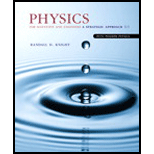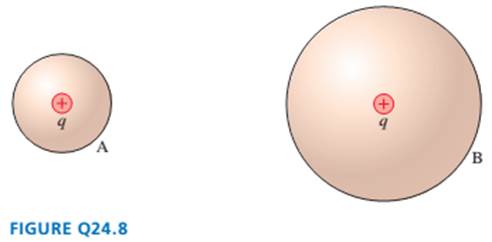
Physics for Scientists and Engineers: A Strategic Approach with Modern Physics (4th Edition)
4th Edition
ISBN: 9780133942651
Author: Randall D. Knight (Professor Emeritus)
Publisher: PEARSON
expand_more
expand_more
format_list_bulleted
Concept explainers
Textbook Question
Chapter 24, Problem 8CQ
The two spheres in FIGURE Q24.8 on the next page surround equal charges. Three students are discussing the situation.
Student 1 : The fluxes through spheres A and B are equal because they enclose equal charges.
Student 2: But the electric field on sphere B is weaker than the electric field on sphere A. The flux depends on the electric field strength, so the flux through A is larger than the flux through B.
Student 3: I thought we learned that flux was about surface area. Sphere B is larger than sphere A, so I think the flux through B is larger than the flux through A. Which of these students, if any, do you agree with? Explain.

Expert Solution & Answer
Want to see the full answer?
Check out a sample textbook solution
Students have asked these similar questions
Please solve and answer this problem correctly please. Thank you!!
You're on an interplanetary mission, in an orbit around the Sun. Suppose you make a maneuver that brings your perihelion in closer to the Sun but leaves your aphelion unchanged. Then you must have
Question 2 options:
sped up at perihelion
sped up at aphelion
slowed down at perihelion
slowed down at aphelion
The force of the quadriceps (Fq) and force of the patellar tendon (Fp) is identical (i.e., 1000 N each). In the figure below angle in blue is Θ and the in green is half Θ (i.e., Θ/2). A) Calculate the patellar reaction force (i.e., R resultant vector is the sum of the horizontal component of the quadriceps and patellar tendon force) at the following joint angles: you need to provide a diagram showing the vector and its components for each part. a1) Θ = 160 degrees, a2) Θ = 90 degrees. NOTE: USE ONLY TRIGNOMETRIC FUNCTIONS (SIN/TAN/COS, NO LAW OF COSINES, NO COMPLICATED ALGEBRAIC EQUATIONS OR ANYTHING ELSE, ETC. Question A has 2 parts!
Chapter 24 Solutions
Physics for Scientists and Engineers: A Strategic Approach with Modern Physics (4th Edition)
Ch. 24 - Suppose you have the uniformly charged cube in...Ch. 24 - FIGURE Q24.2 shows cross sections of...Ch. 24 - The square and circle in FIGURE Q24.3 are in the...Ch. 24 - Prob. 4CQCh. 24 - Prob. 5CQCh. 24 - What is the electric flux through each of the...Ch. 24 - Prob. 7CQCh. 24 - The two spheres in FIGURE Q24.8 on the next page...Ch. 24 - The sphere and ellipsoid in FIGURE Q24.9 surround...Ch. 24 - A small, metal sphere hangs by an insulating...
Ch. 24 - l. FIGURE EX24.1 shows two cross sections of two...Ch. 24 - FIGURE EX24.2 shows a cross section of two...Ch. 24 - FIGURE EX24.3 shows a cross section of two...Ch. 24 - The electric field is constant over each face of...Ch. 24 - The electric field is constant over each face of...Ch. 24 - The cube in FIGURE EX24.6 contains negative...Ch. 24 - The cube in FIGURE EX24.7 contains negative...Ch. 24 - The cube in FIGURE EX24.8 contains no net charge....Ch. 24 - What is the electric flux through the surface...Ch. 24 - What is the electric flux through the surface...Ch. 24 - II The electric flux through the surface shown in...Ch. 24 - ]12. A 2.0cm3.0cm rectangle lies in the xy-plane....Ch. 24 - A 2.0cm3.0cm rectangle lies in the xz-plane. What...Ch. 24 - Prob. 14EAPCh. 24 - 15. A box with its edges aligned with
the...Ch. 24 - What is the net electric flux through the two...Ch. 24 - FIGURE EX24.17 shows three charges. Draw these...Ch. 24 - Prob. 18EAPCh. 24 - FIGURE EX24.19 shows three Gaussian surfaces and...Ch. 24 - What is the net electric flux through the torus...Ch. 24 - What is the net electric flux through the cylinder...Ch. 24 - Prob. 22EAPCh. 24 - Prob. 23EAPCh. 24 - A spark occurs at the tip of a metal needle if the...Ch. 24 - The electric field strength just above one face of...Ch. 24 - The conducting box in FIGURE EX24.26 has been...Ch. 24 - FIGURE EX24.27 shows a hollow cavity within a...Ch. 24 - A thin, horizontal, 10-cm-diameter copper plate is...Ch. 24 - Prob. 29EAPCh. 24 - Prob. 30EAPCh. 24 - II A tetrahedron has an equilateral triangle base...Ch. 24 - Charges q1= —4Q and q2= +2Q are located at x = —a...Ch. 24 - Prob. 33EAPCh. 24 - A spherically symmetric charge distribution...Ch. 24 - A neutral conductor contains a hollow cavity in...Ch. 24 - Prob. 36EAPCh. 24 - 37. A 20-cm-radius ball is uniformly charged to 80...Ch. 24 - Prob. 38EAPCh. 24 - Prob. 39EAPCh. 24 - Prob. 40EAPCh. 24 - A hollow metal sphere has 6 cm and 10 cm inner and...Ch. 24 - Prob. 42EAPCh. 24 - Find the electric field inside and outside a...Ch. 24 - Prob. 44EAPCh. 24 - Prob. 45EAPCh. 24 - Prob. 46EAPCh. 24 - FIGURE P24.47 shows an infinitely wide conductor...Ch. 24 - FIGURE P24.48 shows two very large slabs of metal...Ch. 24 - Prob. 49EAPCh. 24 - A very long, uniformly charged cylinder has radius...Ch. 24 - Prob. 51EAPCh. 24 - Prob. 52EAPCh. 24 - II A long cylinder with radius b and volume charge...Ch. 24 - A spherical shell has inner radius Rin, and outer...Ch. 24 - Prob. 55EAPCh. 24 - Newton's law of gravity and Coulomb's law are both...Ch. 24 - Prob. 57EAPCh. 24 - An infinite cylinder of radius R has a linear...Ch. 24 - Prob. 59EAPCh. 24 - A sphere of radius R has total charge Q. The...Ch. 24 - II A spherical ball of charge has radius R and...
Knowledge Booster
Learn more about
Need a deep-dive on the concept behind this application? Look no further. Learn more about this topic, physics and related others by exploring similar questions and additional content below.Similar questions
- The force of the quadriceps (Fq) and force of the patellar tendon (Fp) is identical (i.e., 1000 N each). In the figure below angle in blue is Θ and the in green is half Θ (i.e., Θ/2). A) Calculate the patellar reaction force (i.e., R resultant vector is the sum of the horizontal component of the quadriceps and patellar tendon force) at the following joint angles: you need to provide a diagram showing the vector and its components for each part. a1) Θ = 160 degrees, a2) Θ = 90 degrees. NOTE: USE DO NOT USE LAW OF COSINES, NO COMPLICATED ALGEBRAIC EQUATIONS OR ANYTHING ELSE, ETC. Question A has 2 parts!arrow_forwardNo chatgpt pls will upvotearrow_forwardThe force of the quadriceps (Fq) and force of the patellar tendon (Fp) is identical (i.e., 1000 N each). In the figure below angle in blue is Θ and the in green is half Θ (i.e., Θ/2). A) Calculate the patellar reaction force (i.e., R resultant vector is the sum of the horizontal component of the quadriceps and patellar tendon force) at the following joint angles: you need to provide a diagram showing the vector and its components for each part. a1) Θ = 160 degrees, a2) Θ = 90 degrees. NOTE: USE ONLY TRIGNOMETRIC FUNCTIONS (SIN/TAN/COS, NO LAW OF COSINES, NO COMPLICATED ALGEBRAIC EQUATIONS OR ANYTHING ELSE, ETC. Question A has 2 parts!arrow_forward
- ་ The position of a particle is described by r = (300e 0.5t) mm and 0 = (0.3t²) rad, where t is in seconds. Part A Determine the magnitude of the particle's velocity at the instant t = 1.5 s. Express your answer to three significant figures and include the appropriate units. v = Value Submit Request Answer Part B ? Units Determine the magnitude of the particle's acceleration at the instant t = 1.5 s. Express your answer to three significant figures and include the appropriate units. a = Value A ? Unitsarrow_forwardSolve and answer the question correctly please. Thank you!!arrow_forwardSolve and answer the question correctly please. Thank you!!arrow_forward
- A spiral transition curve is used on railroads to connect a straight portion of the track with a curved portion. (Figure 1) Part A v = v₁ft/s 600 ft y = (106) x³ If the spiral is defined by the equation y = (106)³, where x and y are in feet, determine the magnitude of the acceleration of a train engine moving with a constant speed of v₁ = 30 ft/s when it is at point x = 600 ft. Express your answer to three significant figures and include the appropriate units. ? a = Value Unitsarrow_forwardsolve and answer the problem correctly please. Thank you!!arrow_forwardSolve and answer the question correctly please. Thank you!!arrow_forward
arrow_back_ios
SEE MORE QUESTIONS
arrow_forward_ios
Recommended textbooks for you
 Principles of Physics: A Calculus-Based TextPhysicsISBN:9781133104261Author:Raymond A. Serway, John W. JewettPublisher:Cengage Learning
Principles of Physics: A Calculus-Based TextPhysicsISBN:9781133104261Author:Raymond A. Serway, John W. JewettPublisher:Cengage Learning College PhysicsPhysicsISBN:9781305952300Author:Raymond A. Serway, Chris VuillePublisher:Cengage Learning
College PhysicsPhysicsISBN:9781305952300Author:Raymond A. Serway, Chris VuillePublisher:Cengage Learning Physics for Scientists and Engineers with Modern ...PhysicsISBN:9781337553292Author:Raymond A. Serway, John W. JewettPublisher:Cengage Learning
Physics for Scientists and Engineers with Modern ...PhysicsISBN:9781337553292Author:Raymond A. Serway, John W. JewettPublisher:Cengage Learning Physics for Scientists and Engineers, Technology ...PhysicsISBN:9781305116399Author:Raymond A. Serway, John W. JewettPublisher:Cengage Learning
Physics for Scientists and Engineers, Technology ...PhysicsISBN:9781305116399Author:Raymond A. Serway, John W. JewettPublisher:Cengage Learning Physics for Scientists and Engineers: Foundations...PhysicsISBN:9781133939146Author:Katz, Debora M.Publisher:Cengage Learning
Physics for Scientists and Engineers: Foundations...PhysicsISBN:9781133939146Author:Katz, Debora M.Publisher:Cengage Learning Physics for Scientists and EngineersPhysicsISBN:9781337553278Author:Raymond A. Serway, John W. JewettPublisher:Cengage Learning
Physics for Scientists and EngineersPhysicsISBN:9781337553278Author:Raymond A. Serway, John W. JewettPublisher:Cengage Learning

Principles of Physics: A Calculus-Based Text
Physics
ISBN:9781133104261
Author:Raymond A. Serway, John W. Jewett
Publisher:Cengage Learning

College Physics
Physics
ISBN:9781305952300
Author:Raymond A. Serway, Chris Vuille
Publisher:Cengage Learning

Physics for Scientists and Engineers with Modern ...
Physics
ISBN:9781337553292
Author:Raymond A. Serway, John W. Jewett
Publisher:Cengage Learning

Physics for Scientists and Engineers, Technology ...
Physics
ISBN:9781305116399
Author:Raymond A. Serway, John W. Jewett
Publisher:Cengage Learning

Physics for Scientists and Engineers: Foundations...
Physics
ISBN:9781133939146
Author:Katz, Debora M.
Publisher:Cengage Learning

Physics for Scientists and Engineers
Physics
ISBN:9781337553278
Author:Raymond A. Serway, John W. Jewett
Publisher:Cengage Learning
Electric Fields: Crash Course Physics #26; Author: CrashCourse;https://www.youtube.com/watch?v=mdulzEfQXDE;License: Standard YouTube License, CC-BY